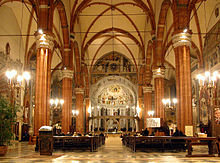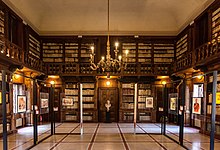
Michele Sanmicheli, sometimes also transcribed as Sammicheli, Sanmichele or Sammichele, was an Italian architect and urban planner who was a citizen of the Republic of Venice.
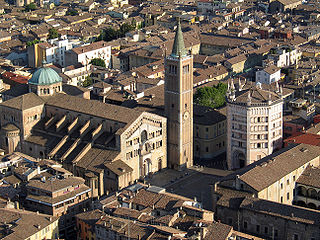
Parma Cathedral is a Roman Catholic cathedral in Parma, Emilia-Romagna (Italy), dedicated to the Assumption of the Blessed Virgin Mary. It is the episcopal seat of the Diocese of Parma. It is an important Italian Romanesque cathedral: the dome, in particular, is decorated by a highly influential illusionistic fresco by Renaissance painter Antonio da Correggio.

Genoa Cathedral or Metropolitan Cathedral of Saint Lawrence is a Roman Catholic cathedral in the Italian city of Genoa. It is dedicated to Saint Lawrence, and is the seat of the Archbishop of Genoa. The cathedral was consecrated by Pope Gelasius II in 1118 and was built between the twelfth century and the fourteenth century as fundamentally a medieval building, with some later additions. Secondary naves and side covers are of Romanesque style and the main facade is Gothic from the early thirteenth century, while capitals and columns with interior corridors date from the early fourteenth century. The bell tower and dome were built in the sixteenth century.

Mantua Cathedral in Mantua, Lombardy, northern Italy, is a Roman Catholic cathedral dedicated to Saint Peter. It is the seat of the Bishop of Mantua.

Prato Cathedral, or Cathedral of Saint Stephen, is a Roman Catholic cathedral in Prato, Tuscany, Central Italy, from 1954 the seat of the Bishop of Prato, having been previously, from 1653, a cathedral in the Diocese of Pistoia and Prato. It is dedicated to Saint Stephen, the first Christian martyr.

Padua Cathedral, or Basilica Cathedral of Saint Mary of the Assumption, is a Catholic church and minor basilica located on the east end of Piazza Duomo, adjacent to the bishop's palace in Padua, Veneto, Italy.

The church of San Pietro da Verona in Santa Anastasia, better known as the basilica of Santa Anastasia, is an important Catholic place of worship that stands in the heart of the historic center of Verona; it is located at the end of the decumanus maximus of the city in Roman times, near the point where the wide meander of the Adige river is crossed by the Ponte Pietra, where the two main traffic routes of the city, road and river, gravitate. It is the largest, most solemn and representative church in Verona, a reflection of a lively moment in the city's life, when the expansion and consolidation of political and economic institutions allowed the community, in synergy with the Scaliger rule, the Dominican clergy and the Castelbarco family, to make a considerable financial effort to build this important temple, a symbol of their power.
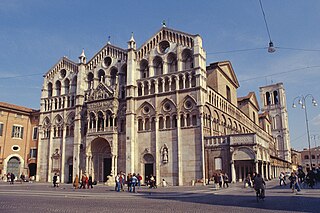
Ferrara Cathedral is a Roman Catholic cathedral and minor basilica in Ferrara, Northern Italy. Dedicated to Saint George, the patron saint of the city, it is the seat of the Archbishop of Ferrara and the largest religious building in the city.

Saint Justus of Trieste is a saint venerated in the Eastern Orthodox Church and Roman Catholic Church.

The Codex Veronensis, designated by the siglum b or 4, is a 5th-century Latin manuscript of the four Gospels, written on vellum which has been dyed purple. The text is written in silver and occasionally gold ink, and is a version of the old Latin New Testament Gospels. The Gospels follow in the Western order.

Amalfi Cathedral is a medieval Roman Catholic cathedral in the Piazza del Duomo, Amalfi, Italy. It is dedicated to the Apostle Saint Andrew whose relics are kept here. Formerly the archiepiscopal seat of the Diocese of Amalfi, it has been since 1986 that of the Diocese of Amalfi-Cava de' Tirreni.

Udine Cathedral is a Catholic cathedral located in Udine, north-eastern Italy. It is the seat of the Archbishop of Udine.

Cagliari Cathedral is a Roman Catholic cathedral in Cagliari, Sardinia, Italy, dedicated to the Virgin Mary and to Saint Cecilia. It is the seat of the archbishop of Cagliari.
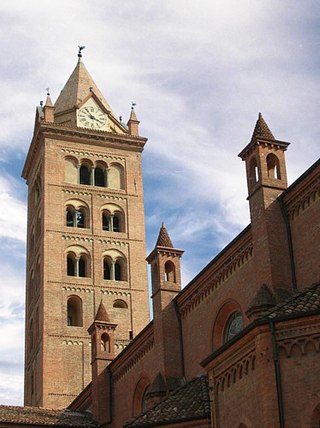
Alba Cathedral is a Roman Catholic cathedral in Alba, province of Cuneo, Piedmont, Italy, dedicated to Saint Lawrence. It is the episcopal seat of the Diocese of Alba.
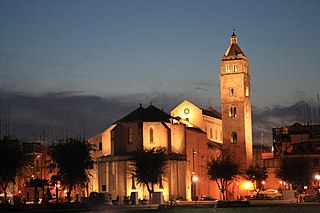
Barletta Cathedral is a Roman Catholic cathedral in Barletta, Apulia, southern Italy. Formerly the seat of the archbishops of Barletta and Nazareth, it is currently a co-cathedral in the Archdiocese of Trani-Barletta-Bisceglie. It was built in two different styles, Romanesque and Gothic, from the 12th century to the 14th century.

Ancona Cathedral is a Roman Catholic cathedral in Ancona, central Italy, dedicated to Saint Cyriacus. It is the seat of the Archbishop of Ancona. The building is an example of mixed Romanesque-Byzantine and Gothic elements, and stands on the site of the former acropolis of the Greek city, the Guasco hill which overlooks Ancona and its gulf.

The church of Sant'Eufemia is a Catholic place of worship located in the heart of Verona's historic center. It straddles an ancient Roman cardo, where a church building probably already existed in the 6th century. The foundation of the present church is owed to the Della Scala family, who brought Augustinian hermit monks to Verona in 1262 so that they could be closer to the community and granted them permission to build a monastery, located at the time in the Capitani quarter of the Scaliger city. Through bequests and donations, particularly that of Alberto della Scala, the building could be consecrated in 1331 by the bishop of Verona Nicolò. The building activity, however, did not end, and in the following years the monastery's rooms continued to be expanded in order to accommodate the increasing number of monks who arrived there attracted by the great prestige the community boasted. A permit granted by Mastino II della Scala in 1340 made it possible to further enlarge the church by building the vast apse that still distinguishes it today. From the end of the fourteenth century work continued on the various chapels and minor altars.

Comacchio Cathedral, also the Basilica of San Cassiano, is a Baroque Roman Catholic cathedral and minor basilica dedicated to Saint Cassian of Imola in the city of Comacchio, in the province of Ferrara, Emilia-Romagna, Italy. Formerly the seat of the bishops of Comacchio, it has been since 1986 a co-cathedral in the Archdiocese of Ferrara-Comacchio.
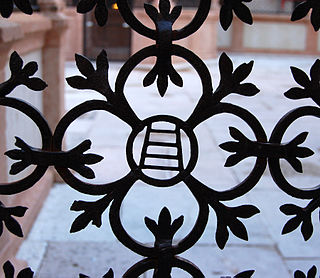
The monuments of Verona are a vast number of architecturally, archaeologically, historically, and artistically significant cultural assets that characterize the city of Verona. Precisely because of the richness of its monuments and the urban evolution that has developed seamlessly over the centuries, UNESCO declared the city a World Heritage Site in 2000.

The churches of Verona are the places of Catholic worship that have been built within the administrative boundaries of the municipality of Verona, evidence of the ups and downs that the city has experienced throughout its history.

